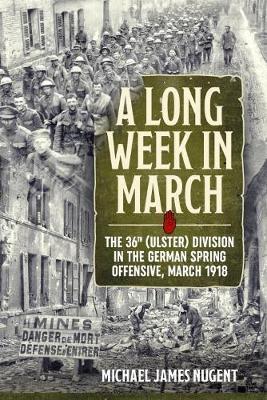Long Week in March

Long Week in March
In this unique and fascinating account, Michael Nugent examines the factors beyond the control of those in the Division which led to them holding the front line opposite the northern French town of St Quentin on the morning of 21 March. These include problems with recruitment in Ireland, the lack of reinforcements being sent to the front, the reorganisation of the British Army in early 1918, and the imposition of a new defensive system which few in the infantry had any faith in.
The opening day of the battle is scrutinised in detail, with the experiences of each of the Infantry battalions forming the Division being analysed. In the case of 12th and 15th Battalions Royal Irish Rifles, this is the first time an account of the actions of this momentous day have been committed to print. The accounts are drawn from battalion war diaries, personal accounts and the regimental history of the German attackers which provides a fascinating insight and helps to corroborate accounts from the Ulster Division. The actions leading to the award of the two Victoria Crosses won by the Division in the last week of March are investigated, with new information, particularly concerning the award to 2nd Lieutenant Edmund de Wind being made available.
Each day of the withdrawal is investigated with important events being analysed in detail, including the `last stand' of the 2nd Battalion Royal Irish Rifles on 24 March and the Cavalry Charge by elements of the 3rd Cavalry Division on the same date, which undoubtedly saved an organised withdrawal from becoming a rout.
A chapter is devoted to the analysis of casualty figures with each of the fatalities identified and their details contained in an appendix. The varied experiences of those taken prisoner is also examined using personal accounts which highlight that the
180.00Lei
180.00Lei
Livrare in 2-4 saptamani
Descrierea produsului
In this unique and fascinating account, Michael Nugent examines the factors beyond the control of those in the Division which led to them holding the front line opposite the northern French town of St Quentin on the morning of 21 March. These include problems with recruitment in Ireland, the lack of reinforcements being sent to the front, the reorganisation of the British Army in early 1918, and the imposition of a new defensive system which few in the infantry had any faith in.
The opening day of the battle is scrutinised in detail, with the experiences of each of the Infantry battalions forming the Division being analysed. In the case of 12th and 15th Battalions Royal Irish Rifles, this is the first time an account of the actions of this momentous day have been committed to print. The accounts are drawn from battalion war diaries, personal accounts and the regimental history of the German attackers which provides a fascinating insight and helps to corroborate accounts from the Ulster Division. The actions leading to the award of the two Victoria Crosses won by the Division in the last week of March are investigated, with new information, particularly concerning the award to 2nd Lieutenant Edmund de Wind being made available.
Each day of the withdrawal is investigated with important events being analysed in detail, including the `last stand' of the 2nd Battalion Royal Irish Rifles on 24 March and the Cavalry Charge by elements of the 3rd Cavalry Division on the same date, which undoubtedly saved an organised withdrawal from becoming a rout.
A chapter is devoted to the analysis of casualty figures with each of the fatalities identified and their details contained in an appendix. The varied experiences of those taken prisoner is also examined using personal accounts which highlight that the
Detaliile produsului










